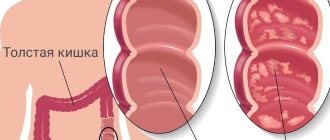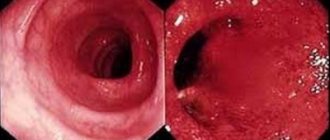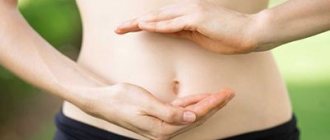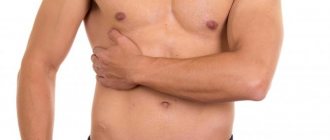Home » Intestinal colitis
Intestinal colitis is an inflammatory process that develops in the large intestine and affects the mucous membrane. Serious dystrophy and functional disorders of internal organs are observed. This pathology is considered independent and has many symptoms that are chronic or acute. Signs of intestinal colitis depend on the form and stage of the disease, on the location of the inflammation, on the nature of the pain and changes in the internal organs.
Acute intestinal colitis, symptoms
A disease called intestinal colitis is accompanied by a number of symptoms. The pain is cutting in nature and often intensifies with movement. Acute colitis develops after infection or after intoxication of the body.
The following symptoms of proctological disease are distinguished:
- pain syndrome:
Throughout the day, the patient experiences severe pain in the stomach. Unpleasant sensations intensify with any physical activity and even with coughing or sneezing.
- temperature increase;
An inflammatory process develops in the body during colitis, as a result of which in most cases the patient’s temperature rises to 39°C.
- gastrointestinal disorders;
A common disease is bowel movement disorder. The patient suffers from frequent urge to go to the toilet. Diarrhea is accompanied by an increase in blood pressure, the mucous membrane is irritated. With constipation, anal fissures form in the anus.
The patient feels cramping pain in the intestines and the abdomen is bloated. Feces stagnate in the body and fecal stones form. Feces increase in size and lead to intoxication of the body. Frequent urge to go to the toilet sometimes does not lead to bowel movement, during which the walls of the anus are injured.
- impurities in feces;
Impurities of blood, mucus and even pus are found in the stool. The blood is dark brown in color. This symptom indicates an inflammatory process.
- flatulence and heaviness in the abdomen;
After eating, the patient is bothered by flatulence and bloating. Gas formation brings discomfort and disrupts the usual way of life. My stomach is constantly growling. Regardless of food intake, severe discomfort is felt in the stomach area.
- lack of appetite;
Due to problems associated with digestion, the patient has no appetite throughout the day.
- nausea and vomiting;
Nausea is observed after eating. Sometimes vomiting begins, in which impurities of mucus and blood appear.
- cardiac system disorders;
All body systems are interconnected, so in some cases there is an increase in blood pressure, dizziness, and tachycardia.
Signs of intestinal colitis in women are similar to pathological processes in the urinary and reproductive systems. Patients often confuse colitis with problems of the uterus and appendages. If abdominal pain intensifies during sexual intercourse, or vaginal discharge appears, then we are talking about gynecological problems.
In acute intestinal colitis, the symptoms vary in nature and intensity. In the early stages, pain appears extremely rarely and does not cause discomfort to the patient. In advanced stages, the pain does not stop throughout the day and does not disappear even after taking painkillers.
If any signs appear, you should contact a medical specialist, namely a proctologist. The private proctology clinic “Proctologist 81” employs highly qualified specialists and doctors of the highest category. For each patient they select an individual treatment method. Diagnosis of the body is carried out using modern technologies and the latest equipment.
Causes
Seasonal factors can provoke catarrhal colitis. For example, in the summer, with an abundance of vegetables and fruits, there is a risk of eating them unwashed. In combination with a poor diet and a low level of immunity, infection with pathogenic microorganisms triggers the development of an inflammatory process on the mucous membranes of the digestive organs. Common causes of the disease include an unbalanced diet.
Sudden changes in diet (for example, when following a diet) can also be a trigger for colitis.
Main reasons:
In the photo you can see different pictures of damage to the colon, associated with the scale of the inflammatory process and its localization. compliance with too strict dietary programs;- progression of intestinal dysbiosis;
- infection with parasitic infections;
- a critical decrease in the body's protective functions;
- complications of food poisoning;
- deficiency of minerals in the body;
- uncontrolled use of medications;
- progression of ischemic colitis;
- complications of chronic constipation;
- consequences of injuries to the intestine and its mucous membranes;
- exacerbation of chronic pathologies of the digestive tract.
Chronic intestinal colitis, symptoms
Acute colitis of the sigmoid colon and rectum passes into the chronic stage if the disease is not cured in time. Symptoms appear from time to time, and in the chronic stage they bother the patient every day.
The following signs of the chronic stage of proctological disease are distinguished:
| 1. problems with bowel movements; | In chronic intestinal colitis, both diarrhea and constipation are common symptoms. Constipation occurs much more often, and is accompanied by colic in the stomach, bloating, and flatulence. Increased secretion of intestinal gases occurs after eating. |
| 2. disturbed structure of feces; | Feces have a strange greenish tint and a sour smell. The stool contains mucus, streaks of blood, and pus. |
| 3. nausea and vomiting; | If toxins enter the bloodstream during intestinal inflammation, nausea and vomiting occur. There is an unpleasant odor coming from the mouth. |
| 4. skin rashes; | In some cases, with colitis, intoxication occurs in the body. As a result, rashes appear on the skin, which requires the attention of a dermatologist and proctologist. |
| 5. weight loss; | Due to digestive problems, the patient loses his appetite. He is rapidly losing weight, which leads to hypovitaminosis and decreased immunity. |
| 6. impaired metabolism; | With colitis, metabolism is disrupted, anemia or anemia is observed. |
| 7. problems with blood vessels; | Colitis is accompanied by dizziness, low and high blood pressure. General weakness and drowsiness appear. |
Symptoms of intestinal colitis in men appear with excessive physical activity, drinking alcoholic beverages, and smoking. Painful sensations appear in the stomach and chest. Often these symptoms are confused with heart problems.
What tests to do if your lungs hurt?
The main examination to determine the cause of lung pain is a history and x-ray. An imaging test in the form of a chest x-ray is then usually performed, as well as an ECG and arterial oxygen saturation (saturation measurement) using a small device called a pulse oximeter. If reflux or other digestive system diseases are suspected, your doctor may order an upper endoscopy or gastroscopy. Based on the research results, further measures are planned and therapy is selected.
Types of intestinal colitis by location
The large intestine is separated from the small intestine using a special valve. This intestine consists of the colon, rectum and cecum. The colon is considered the longest. It is divided into sigmoid, descending, transverse and ascending parts. On average, the length of the large intestine in an adult is one and a half meters.
The following types of colitis are distinguished by location in the intestines:
- Pancolitis - the entire large intestine is affected.
- Typhlitis is accompanied by inflammation exclusively in the cecum.
- Transversitis - the transverse part of the colon becomes inflamed.
- Sigmoiditis - affects the sigmoid colon.
- Proctitis - inflammation of the rectum.
Patients are also diagnosed with rectosigmoiditis . With this disease, the sigmoid and rectum are affected, which is extremely dangerous for human health.
There are also left-sided, right-sided and diffuse colitis. Diffuse colitis is associated with the large and small intestines.
Methods for diagnosing the disease and preparing for them
Human thick intestine
In order to make an accurate diagnosis of colitis and its type, I use special methods of examining the large intestine. The data obtained make it possible to determine the severity of the disease as accurately as possible and prescribe the most appropriate treatment accordingly. There are two methods for diagnosing colitis.
The first method includes laboratory blood tests, which show the presence of inflammation in the body. For reliable results, blood is donated on an empty stomach.
Left-sided intestinal inflammation
With left-sided inflammation, the left side is affected. Diagnosed in most cases. This type of colitis is diagnosed when the descending colon, rectum and sigmoid colon become inflamed. The patient is concerned about constipation, increased intra-abdominal pressure, irritation of the mucous membrane and the appearance of anal fissures.
, mucus and blood impurities are found in the stool . The patient feels a frequent urge to defecate, but mucus with small amounts of feces comes out of the body.
Prevention
In most cases, the symptoms of catarrhal colitis are a consequence of poor personal hygiene or poor nutrition. Eliminating these factors helps reduce the risk of inflammation. Products that are intended for fresh consumption (vegetables, fruits, berries) must be fully processed to remove contamination. Regular quick snacks can disrupt the functional state of the digestive tract and provoke the onset of colitis.
Other preventive measures:
- strengthening the body’s immune system (taking vitamins, eating healthy foods, healthy lifestyle);
- regular examination by a gastroenterologist (especially if there are signs of abnormalities in the digestive tract);
- avoiding uncontrolled use of medications that can have a negative effect on the digestive tract and intestinal microflora.
Diffuse intestinal inflammation
It is one of the most severe forms of colitis. Inflammation spreads to the entire colon. The stomach hurts both in the center and on the sides. The pain intensifies when walking, moving and coughing. Sometimes the pain spreads to one side and intensifies if the patient lies on the other side. The nature of the pain is usually aching and dull.
Patients confuse diffuse inflammation with pyelonephritis or pathologies of the cardiac system. There is a frequent urge to go to the toilet, and the intestinal mucosa is irritated. Fecal masses have a small volume. The stool has a greenish tint and contains mucus and blood.
Treatment with modern medicines
In case of acute enteritis, hospitalization is necessary; in a hospital setting, gastric lavage with a tube and bowel cleansing with laxatives are required. Acute intoxication is treated by drip administration of Ringer's solution, Trisol, and glucose. The intestinal flora is restored with the help of Intestopan, Bifikol, Colibacterin, Enteroseptol.
In case of chronic enteritis, antibacterial agents are not used to avoid dysbacteriosis. The flora is restored with the help of Linex, Bifidumbacterin, Lactobacterin. Panzinorm, Meksaza, Abomin, analogues of Enteroseptol, Intestopan are used. Diarrhea is stopped with drugs such as Imodium, Loperamide.
Acute colitis of infectious origin is treated in a specialized department of the hospital, where patients undergo a course of antibacterial therapy. For other forms of colitis, enveloping drugs (Kaolin), astringents (Bismuth drugs), and enzyme drugs (Bifikol, Colibacterin, Linex) are prescribed.
In chronic colitis, the main focus of therapy is aimed at normalizing the intestinal microflora. The patient is first given the shortest possible short course of antibiotics to destroy pathogenic microorganisms. Then treatment with eubiotics and probiotics occurs.
Types of intestinal colitis according to the nature of damage to the mucosa
There are several types of colitis based on the nature of damage to the walls of the large intestine. There is catarrhal, atrophic, erosive, fibrinous and ulcerative colitis.
| Catarrhal or superficial intestinal colitis |
|
| Erosive colitis |
|
| Atrophic colitis |
|
| Fibrinous colitis |
|
| Ulcerative colitis |
|
For any type of disease, treatment should be started as early as possible to avoid complications and consequences.
“Hand in hand” with dysbiosis
There are two forms of colitis - acute and chronic . In both the first and second cases, the infectious component plays a special role in the occurrence and development of the disease - most often bacterial dysentery . It can be triggered by other representatives of pathogenic microflora (for example, coli bacteria, staphylococci, streptococci, bacteria of the Proteus group, etc.). In other words, colitis goes “hand in hand” with dysbacteriosis. Inflammation can also be caused by previous intestinal infections and poor diet, as well as inadequate therapy with various medications. As practice shows, the causes of inflammation are indeed multiple. Let's summarize the main factors :
- infection in the gastrointestinal tract;
- infection with salmonella, staphylococci and other pathogenic microflora due to consumption of poor-quality food;
- the presence of worms (but not in all cases);
- inadequate, monotonous diet (mainly carbohydrates);
- allergies to certain types of food;
- chronic constipation;
- alcohol abuse;
- neglect of personal hygiene rules (for example, touching food with dirty hands);
- long-term use of certain antibiotics that can provoke dysbacteriosis;
- intoxication (poisoning with lead, arsenic and its preparations, mushrooms);
- nervous and emotional tension, stress.
Colitis ulcerosa - all Stages







